The world of concept cars is a realm of innovation, bold designs, and futuristic visions that capture the imagination of automotive enthusiasts. These concept vehicles often serve as a preview of what the future holds for automotive design and technology. However, as exciting as these prototypes may be, not all of them successfully transition into mass production unscathed. In some cases, the journey from concept to production results in compromises, alterations, and sometimes outright deviations from the groundbreaking ideas that initially sparked our fascination. Join us on a journey through automotive history as we explore 15 concept cars that, despite their promising origins, faced challenges and compromises that ultimately led to their downfall in mass production.
The List of 15 Concept Cars That Were Ruined in Mass Production
1. Isuzu GBX

The 2001 GBX serves as an example of a concept that didn’t directly spawn a production model but significantly influenced the design language of forthcoming vehicles in the manufacturer’s lineup. Drawing inspiration from traditional stagecoaches, the “Gear BoX” design of this SUV featured a distinctive black external frame structure, incorporating a roof rack seamlessly into the upper cross-members. The stylized Isuzu corporate egg-crate grille from that era found a place in several future Isuzu models, most notably the D-Max and Rodeo, although it never quite captured the same impact as seen on the GBX. The closest counterpart Isuzu produced to the GBX might be traced back to the last generation of the Amigo, last seen on the streets in 2008.
2. 1964 Pontiac Banshee
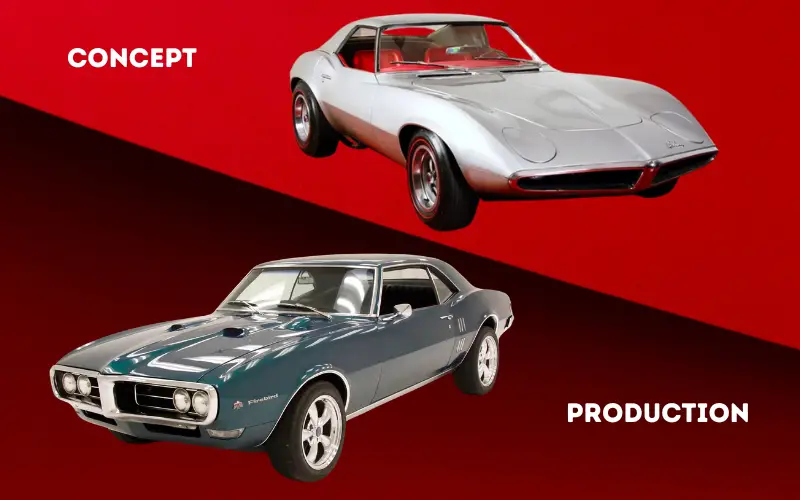
Under the leadership of John DeLorean (yes, the same DeLorean associated with the iconic car), Pontiac greenlit the Banshee concept to enter the competitive arena with Ford’s immensely popular Mustang. Resembling the 1968 Chevrolet Corvette, both the ‘Vette and the Banshee drew significant inspiration from the 1962 Corvair Monza GT. Additionally, the Corvette took direct cues from the Banshee. Despite its potential rivalry with the Corvette, Chevrolet contested this notion, contributing to DeLorean’s inability to push the Banshee into production. Instead, Pontiac introduced the Firebird, the Camaro’s counterpart from Chevrolet. The distinct louvered taillights of the Banshee found a home in the Firebird, while other design elements went on to influence the Opel GT.
3. 1967 Mustang Mach II Concept
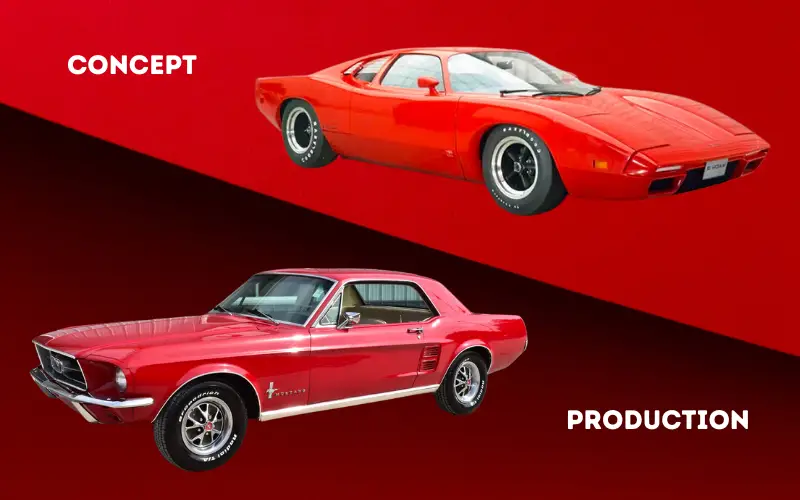
One of the initial visions for the Ford Mustang, the Mustang I, took the form of a mid-engined two-seater. Yet, responding to public demand for a sports car featuring four seats, the production Mustang’s first generation was introduced. Meanwhile, the concept of a mid-engined Mustang persisted and developed into the Mach II concept showcased here. In a parallel pursuit to Chevrolet’s experimentation with a mid-engined Corvette (a journey continuing to the present day), Ford recognized the potential in exploring a similar concept. However, akin to the fate of the Mustang I, the Mustang Mach II concept faced a hurdle: the absence of a rear seat, a factor dictated by public preference. This scenario raises a compelling question: If the Mustang had adopted a mid-engined configuration in 1967, how swiftly might the Corvette have embraced a similar layout?
4. Volkswagen IROC
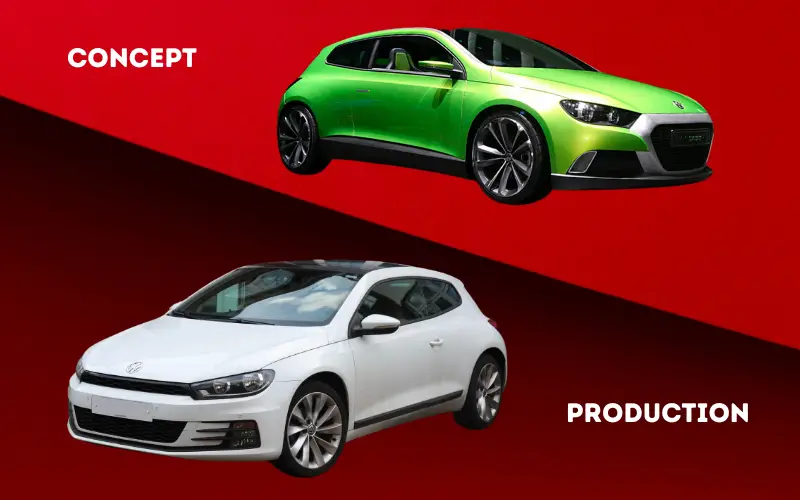
The VW IROC concept, despite its unfortunate name, made a significant impact in 2006 as Volkswagen’s precursor to the reintroduction of the Scirocco, a nameplate absent from the VW lineup since 1992. The concept exhibited a striking design with muscular haunches and a distinctive brushed-aluminum grille surround, exuding sleek sophistication. Despite the concept car’s exaggerated features like tiny mirrors and large wheels, its form remained pure and well-proportioned. When the production Scirocco debuted in 2008, it retained many aspects of the IROC concept, but notable changes, such as a modified grille resembling a Golf derivative slot and reduced muscular flanks, were apparent. The Scirocco’s absence from the U.S. market might be considered fortuitous in light of these alterations.
5. Suzuki Kizashi Concept
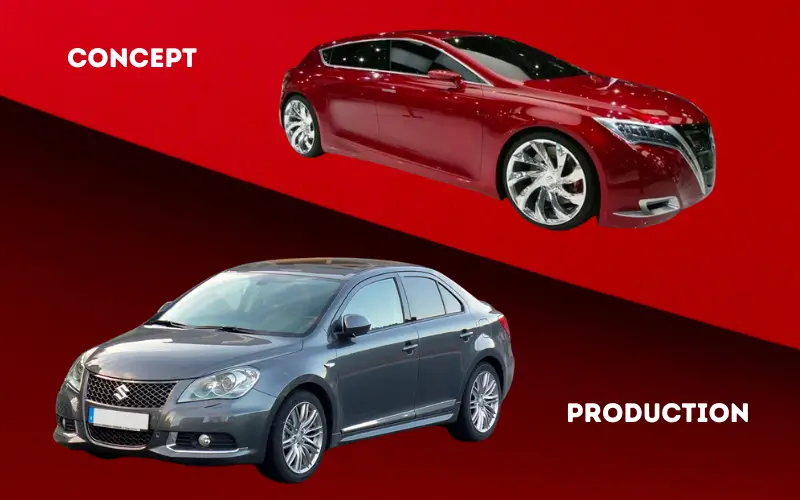
Staying more faithful to the 2007 concept model might not have salvaged Suzuki’s business case in the USA, but it certainly wouldn’t have been detrimental. Featuring a wagon configuration favored by enthusiasts, though not as much by the general public (a sedan concept followed later), the Kizashi showcased a substantial shield grille, headlights gracefully descending on either side, and well-defined shoulders extending along the sides. Unfortunately, the production Kizashi deviated significantly from the concepts, turning out too large to be a compact, too small to be a genuine mid-size, and ahead of its time by exclusively offering a four-cylinder in a segment where all competitors still provided six-cylinder options.
6. Lamborghini Portofino
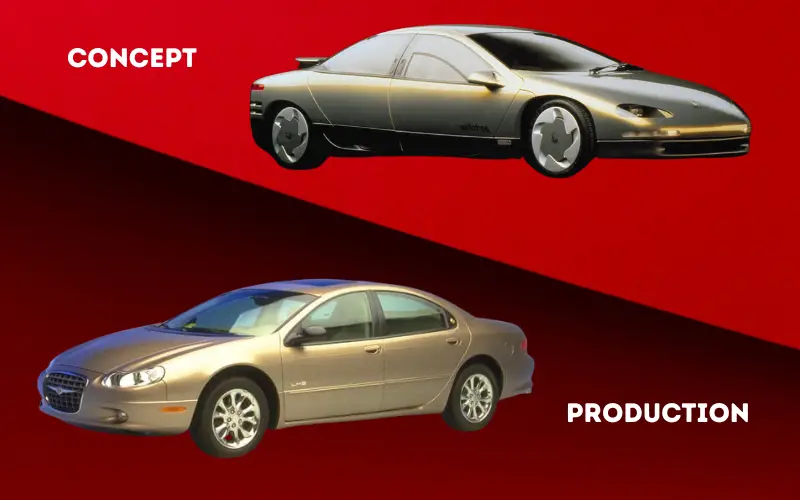
Some might prefer to overlook the fact that Lamborghini was under Chrysler’s ownership from 1987 to 1994. While the Diablo stands out as a prominent outcome of this era, the Portofino concept potentially wielded more influence in terms of overall sales. Emerging as a mid-engined touring car based on the Lamborghini Jalpa platform, the Portofino evolved from an earlier Chrysler concept, the Navajo. While neither Lamborghini nor Chrysler proceeded to produce anything resembling the Portofino, the concept played a pivotal role as it inspired Chrysler’s subsequent “cab-forward” sedan designs from the early 2000s, including models like the Dodge Intrepid, Chrysler Concorde, and Chrysler LHS.
7. 1991 Chrysler 300 Concept
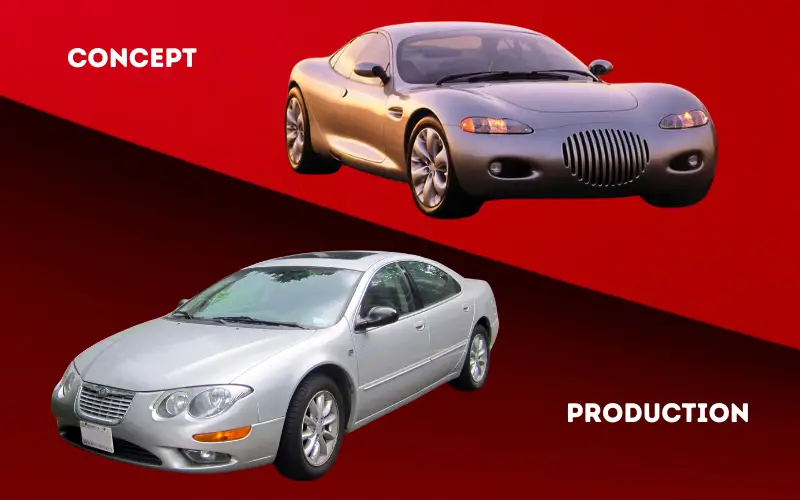
The 300 nameplate has been a recurring presence in Chrysler’s lineup, dating back to the 1950s, with the current model having roots in the Daimler-Chrysler era from 1998 to 2007 when it utilized a platform borrowed from Mercedes-Benz. However, the model’s success has fluctuated over time. Surprisingly, the unassuming 1998 Chrysler 300M can trace its origins to an avant-garde sedan concept from 1991 featuring a Viper V10 engine, rear-wheel drive, and distinctive, swooping design. Despite the concept’s polarizing aesthetics, it was groundbreaking for its utilization of oversized wheels (19-inchers upfront, 20-inchers in the rear) and low-profile tires. Remarkably, it was a fully functional prototype equipped with innovative features like keyless ignition.
8. Toyota Prius C
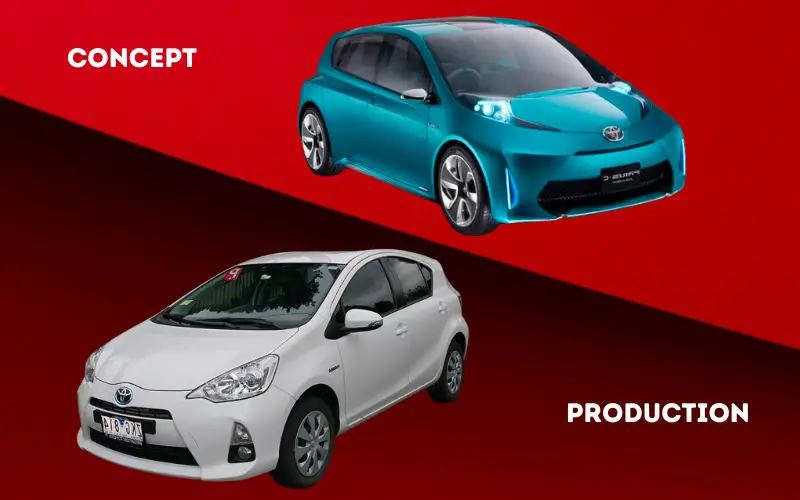
With over six million Prius hybrids sold, Toyota’s groundbreaking model remains the most popular gasoline-electric automobile on the market. While previous designs were notably unique and stood apart from conventional cars, the competitive landscape’s rapid evolution demanded that the fourth-generation Prius C maintain its distinctiveness. The Prius C concept, unveiled in 2011, featured a distinctive headlight design emerging from the base of the windshield and a pronounced shoulder extending from the front door’s leading edge to a substantial shelf over the rear wheels. However, the final production Prius C abandoned the headlight innovation entirely and retained only a subtle nod to the concept car’s shoulder, resulting in a significantly more conventional appearance.
9. BMW 8 Series Concept
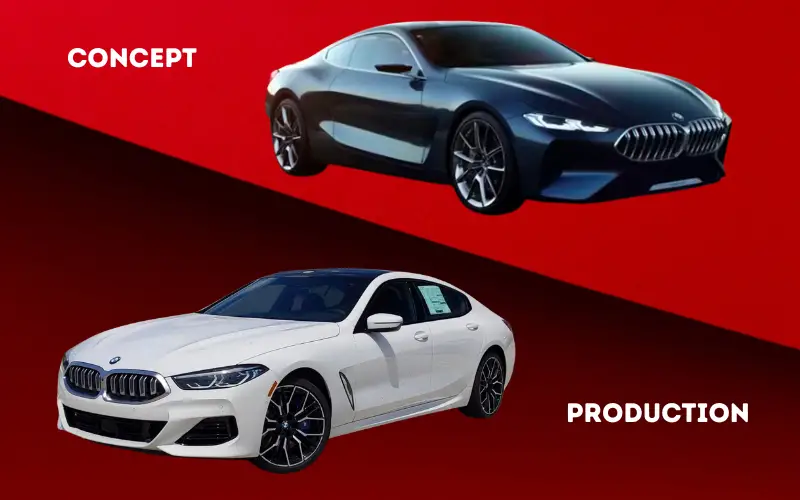
The 8 Series Concept stands as a vivid illustration of a captivating vision that underwent transformations on its journey to becoming the final product. Although BMW’s production 8 Series coupe is undeniably a striking vehicle, its preceding concept was truly breathtaking. While certain intricate details, like the kidney grille extending beyond the bumper, may not have been feasible in a production car, the graceful downward slope of the nose towards the grille seemed attainable, even within the constraints of pedestrian safety regulations. Although the excessively narrow lower trunk opening might have been impractical for real-world usage, the complex interplay of lines and surfaces on the production 8’s rear diverges significantly from the concept’s simple and elegant design.
10. Kia Stinger GT4
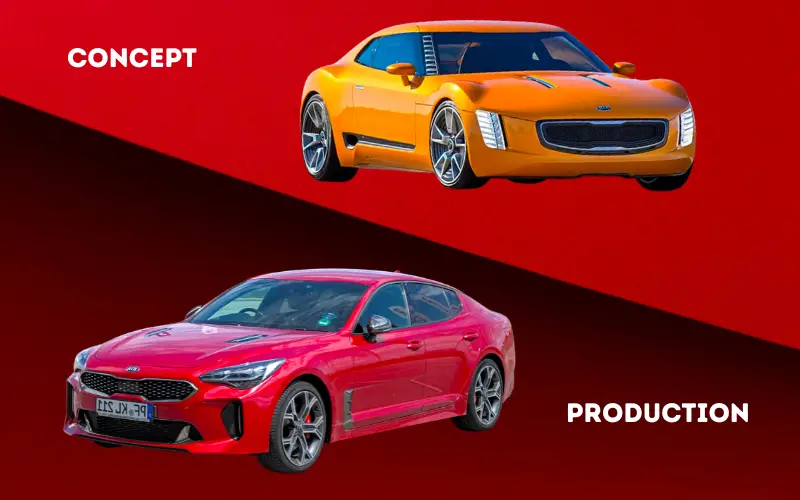
While the Kia Stinger four-door coupe boasts a handsome and aggressive design in its production model, the Stinger GT4 concept takes the allure a step further with a more advanced and unconventional appeal in a classic coupe body. Distinctive elements, such as the unique headlight design, stylized A-pillar details, and the blacked-out rear section between the tail lights, contribute to a futuristic aesthetic that surpasses the production four-door model. Despite the admiration for the concept’s two-door performance, Kia has, at least for the time being, set aside the notion of introducing a true coupe into the market. However, persistent rumors suggest the potential for an electrified version of the GT4, leaving enthusiasts intrigued about the possibilities, especially considering Kia’s reputation for innovative approaches in the automotive realm.
11. Hyundai Intrado
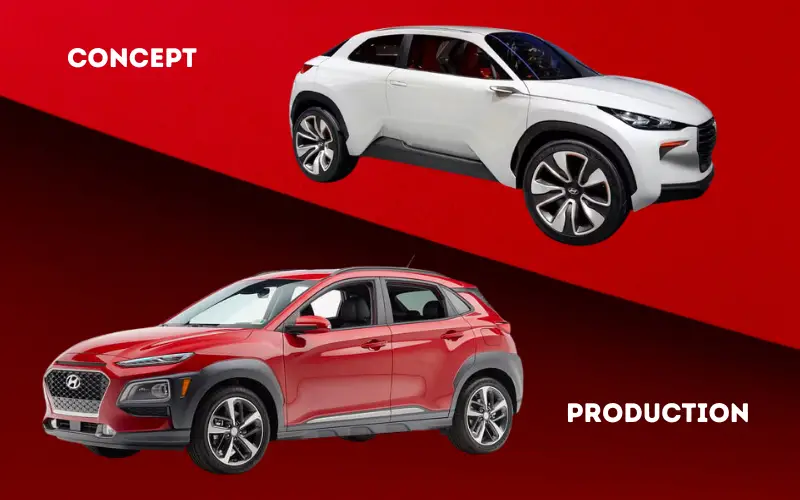
Debuted at the Geneva Motor Show in 2014, the Intrado marked Hyundai’s inaugural concept crafted under the creative direction of Peter Schreyer, the newly appointed chief designer for Hyundai-Kia, renowned for his earlier work on the Audi TT. Before joining Kia, Schreyer made a name for himself at Audi. The Intrado served as Hyundai’s initial venture into the compact SUV segment, foreshadowing the eventual release of the 2018 Kona. As is typical with many concepts, the Intrado exhibits a more audacious design compared to the production Kona, featuring less body cladding and more pronounced sculpting on the lower sides. Despite the surprising thinness of the Kona’s headlight clusters in contrast to the Intrado, the latter’s distinctive tail light detailing, unfortunately, failed to make its way into production.
12. Subaru Impreza Hatch Concept
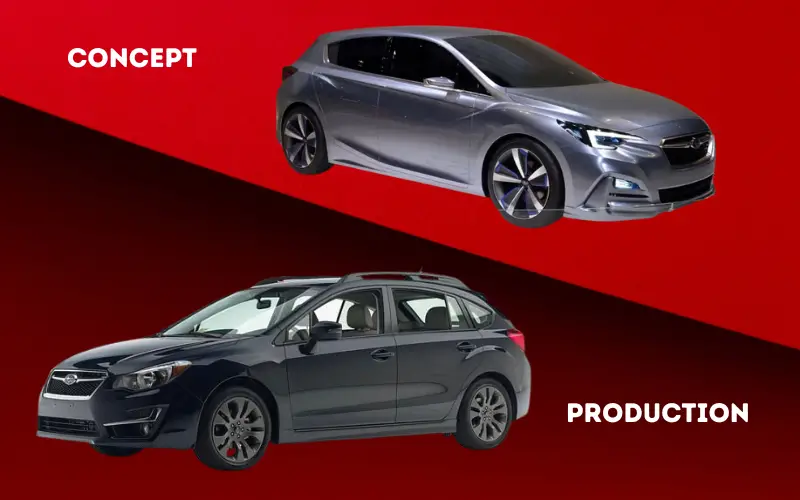
Automakers frequently unveil concept cars in close proximity to the impending release of the production model. Honda, Acura, and Subaru, among others, have followed this trend. However, the question arises: are these concepts authentic development models used to refine the final product, or are they primarily teasers designed to generate anticipation for a design that’s already approved for production? The 2015 Impreza Five-door Concept from Subaru closely resembled the model that eventually reached showrooms about a year later. Despite the close resemblance, several aspects of the show car’s design, including the shape and lines of the headlights, side details’ depth, and the rear bumper’s design, underwent changes in the final product—resulting in a transformation from crisp and tight to somewhat soft and less inspiring. Whether necessary or not, the outcome might be perceived as somewhat disappointing.
13. 1973 Plymouth Barracuda Concept
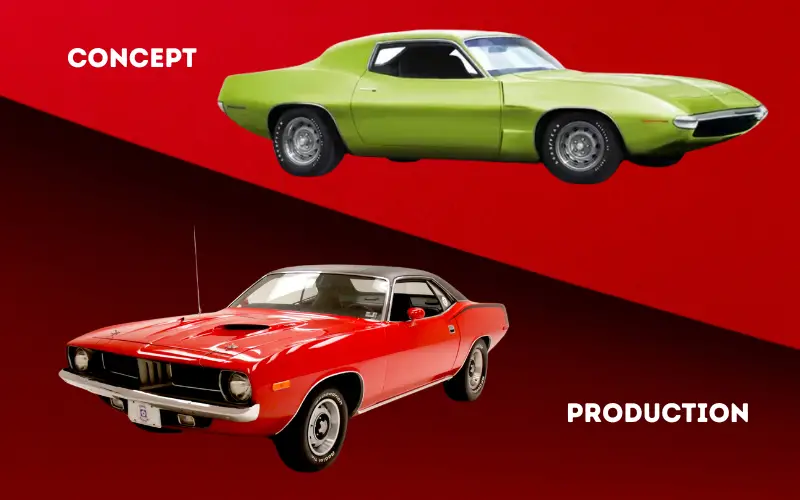
In 1973, the Plymouth Barracuda, a model in continuous production since 1964, faced a pivotal moment. The decision was to either embrace a new design for production or retire the Barracuda in favor of more compact, fuel-efficient options to better align with market demands during the ongoing oil crisis. The 1973 Barracuda concept emerged as a bold attempt to sustain the Barracuda legacy, featuring aerodynamics inspired by the Superbird and muscular design elements. Regrettably, this endeavor proved futile, as a minor refresh of the existing model was ordered, leading to the imminent discontinuation of both the Barracuda and the Dodge Challenger shortly thereafter.
14. BMW Gran Lusso Coupé
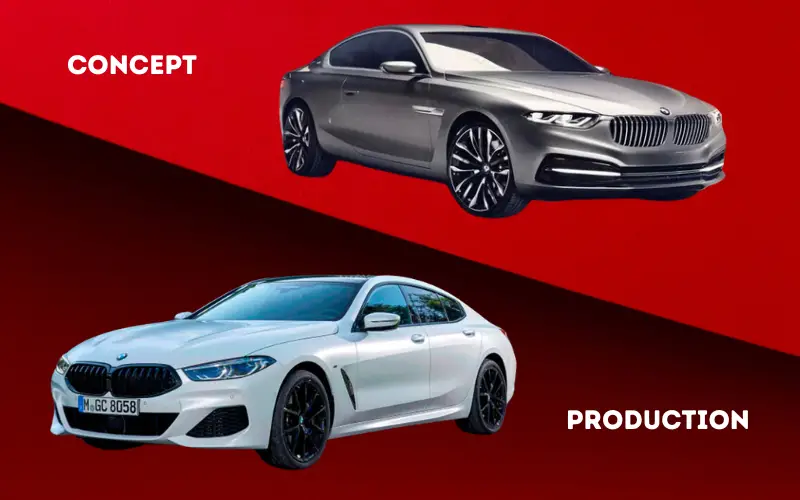
For those affluent driving enthusiasts seeking an ideal means to devour Autobahn or Interstate miles, what could be more fitting than a colossal, 12-cylinder Teutonic coupé? Enter the BMW Gran Lusso Coupé, a manifestation of the marque’s vision in collaboration with Pininfarina, unveiled in 2013 at the Concorso d’Eleganza Villa d’Este. Initially proposed by the design house, the project swiftly transformed from a concept into a tangible model within a mere 12 months. Rooted in the architecture and powerplant of the 7 Series of its time, this design would eventually undergo a metamorphosis into the less flamboyant 2018 8 Series grand tourer.
15. Honda HSV-010 GT
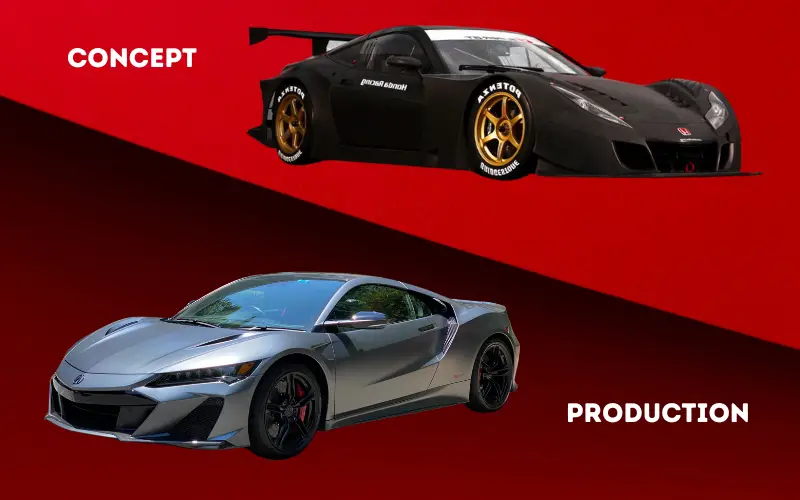
The Acura NSX replacement underwent an extraordinarily protracted development, beginning discussions even before the departure of the first-generation NSX in 2005. During an era preceding the dominance of hybrid hypercars like the McLaren P1 and LaFerrari, talks of a hybrid-powered NSX seemed revolutionary. By 2007, speculation intensified, focusing on a V10-powered NSX, supported by Honda’s unveiling of the Acura Advanced Sports Car Concept with confirmation from Honda CEO Takeo Fukui. Unfortunately, the economic downturn led to the project’s cancellation, giving rise to the Honda HSV-010 GT race car, a glimpse of what the latest NSX might have evolved into if it had endured the challenges.
Conclusion
In the dynamic world of automotive design, the transition from concept to mass production is fraught with challenges and compromises. The 15 concept cars highlighted in this exploration were initially conceived as groundbreaking visions, each carrying the promise of reshaping the automotive landscape. However, the harsh realities of production, market demands, and various constraints led to alterations that, in some cases, diluted the essence of the original concept. While these cars may have lost a bit of their conceptual magic, they serve as a reminder of the delicate dance between innovation and practicality in the ever-evolving automotive industry. Despite their compromised destinies, these concept cars remain a testament to the ongoing pursuit of pushing boundaries and exploring new horizons in the realm of automotive design and technology.
Recent Posts
Science Trivia - Astronomy ...
Step into a realm of nostalgia as we embark on a journey through the annals of pop culture and bid farewell to 35 recently obsolete technologies. In the ever-evolving landscape of innovation, certain...
